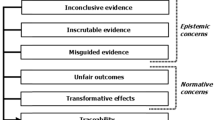Abstract
In the biomedical field, calls for the generation of new regulations or for the amendment of existing regulations often follow the emergence of apparently new research practices (such as embryonic stem cell research), clinical practices (such as facial transplantation) and entities (such as Avian Influenza/’Bird Flu’). Calls for regulatory responses also arise as a result of controversies which bring to light longstanding practices, such as the call for increased regulation of human tissue collections that followed the discovery of unauthorised post-mortem organ retention. Whilst it seems obvious that new regulations should only be generated if existing regulations are inadequate (a practice referred to in this paper as ‘regulatory syncretism’), this does not always occur in practice. This paper examines the conceptual steps involved in generating regulatory responses to emerging phenomena. Two decision points are identified. First, a stance is taken as to whether the emerging phenomenon raises unique ethical or legal issues (exceptionalism versus non-exceptionalism). Second, the decision is made as to whether new regulation should be generated only for truly unique phenomena (syncretism versus asyncretism). It is argued here that it is important to make a careful assessment of novelty, followed by a reflective and deliberate choice of regulatory syncretism or asyncretism, since each type of regulatory response has advantages which need to be harnessed and disadvantages which need to be managed—something that can only occur if regulators are attentive to the choices they are making.
Similar content being viewed by others
References
Mackenzie D. NewScientist.com news service 2004 26 January.
Hettiaratchy S, Butler P. (Commentary) Face transplantation-fantasy or the future? The Lancet 2002;360:5–6.
Australian Law Reform Commission. Essentially yours: the protection of human genetic information in Australia (ALRC96). Canberra: Commonwealth of Australia; 2003.
McPherson J. Antebellum Southern Exceptionalism: a new look at an old question. Civil War History 2004;50(4):418–434.
Koh H. On America's double standard: the good and bad faces of exceptionalism. The American Prospect 2004;15(10):A16–19.
Murphy B. The last, best hope? The perils of American exceptionalism. Commonweal 2004;131(17):20–21.
Lakoff S. The reality of muslim exceptionalism. Journal of Democracy 2004;15(4):133–139.
Bayer R. Public health policy and the AIDS epidemic. An end to HIV exceptionalism? New England Journal of Medicine 1991;324:1500–4.
Hodge Jr J. Ethical issues concerning genetic testing and screening in public health. American Journal of Medical Genetics Part C (Semin.Med. Genet.) 2004;125C:66–70.
Korn D. Dangerous intersections: New proposals to protect genetic privacy may collide with the public interest in fostering medical research. Issues in Science and Technology 1996;13(1):55–62.
Kaplan E. Just say no to AIDS. The Nation 2005;280(4):8.
Casriel E. Promises, promises: big talk aside, Bush's go-it-alone global AIDS strategy is hurting more than it's helping. The American Prospect 2004;15(8):55–57.
Gallo R, Montagnier L. Retrospective: The discovery of HIV as the cause of AIDS. New England Journal of Medicine 2003;349(24):2283–2285.
Rosenbrock R, Dubois-Arber F, Moers M, Pinell P, Schaeffer D, Setbon M. The normalization of AIDS in Western European countries. Social Science εt Medicine 2000;50(11):1607–29.
Jansen LA. HIV exceptionalism CD4+ cell testing, and conscientious subversion. J Med Ethics 2005;31(6):322–6.
Lazzarini R. What lessons can we learn from the exceptionalism debate (finally)? Journal of Law, Medicine εt Ethics 2001;29(2):149–51.
Friedman Ross L. Genetic exceptionalism vs. paradigm shift: lessons from HIV. Journal of Law, Medicine εt Ethics 2001;29(2):141–8.
Casarett D. Have we treated AIDS too well? Rationing and the future of AIDS exceptionalism. Annals of Internal Medicine 1998;128(9):756–759.
Everett M. Can you keep a (genetic) secret? The genetic privacy movement. Journal of Genetic Counseling 2004;13(4):273–291.
Facial Transplantation Working Party report: The Royal College of Surgeons of England; 2003 November.
Furness P. The human tissue bill: criminal sanctions linked to opaque legislation threaten research. BMJ 2004;328:533–4.
National Health and Medical Research Council. Human Research Ethics Handbook. Canberra: Commonwealth of Australia; 2002.
Sarris M, Garrick T, D DS, Haper C. Banking for the future: an Australian experience in Brain Banking. Pathology 2002;34:225–229.
Bauer K, Taub S, Parsi K. Ethical issues in tissue banking for research: A brief review of existing organizational policies. Theoretical Medicine and Bioethics 2004;25(2):113–142.
Trouet C. New European guidelines for the use of stored human biological materials in biomedical research. Journal of Medical Ethics 2004;30(1):99–103.
van Diest P. No consent should be needed for using leftover body material for scientific purposes. For BMJ 2002;325(7365):648–51.
Hair J, McNicol A, Gusterson B. Is research on human tissues at a crossroads? European Journal of Cancer 2003;39:2253–2255.
Agrawal M, Sugden J, Quirke P. Introduction of consent for surgically removed tissue-report of two audits. Journal of Pathology 2003;201 (suppl)(49A).
Ashcroft R. The ethics of reusing archived tissue for research. Neuropathology and Applied Neurobiology 2000;26(5):408–11.
Furness P. Consent to using human tissue: Implied consent should suffice. BMJ 2003;327:759–60.
Ingelfinger J, Drazen J. Registry research and medical privacy. The New England Journal of Medicine 2004;350(14):1452–1453.
Tu J, Willison D, Silver F, Fang J, Richards J, Laupacis A, et al. Impracticability of informed consent in the registry of the Canadian Stroke Network. New England Journal of Medicine 2004;350(14):1414–1421.
Kass N, Natowicz M, Hull SC, Faden R, Plantinga L, Gostin L, et al. The use of medical records in research: what do patients want? Journal of Law, Medicine εt Ethics 2003;31:429–433.
Suter S. The allure and peril of genetics exceptionalism: do we need special genetics legislation? Washington University Law Quarterly 2001;79(3):669–748.
Ellis I, Mannion G, Warren-Jones A. Retained human tissues: a molecular genetics goldmine or modern grave robbing? A legal approach to obtaining and using stored human samples. Medicine and Law 2003;22(3):357–72.
Sowell T. Knowledge and decisions. New York: Basic Books; 1930.
Author information
Authors and Affiliations
Rights and permissions
About this article
Cite this article
Lipworth, W. Generating a taxonomy of regulatory responses to emerging issues in biomedicine. J. Bioethical Inquiry 2, 130–141 (2005). https://doi.org/10.1007/BF02448594
Issue Date:
DOI: https://doi.org/10.1007/BF02448594




